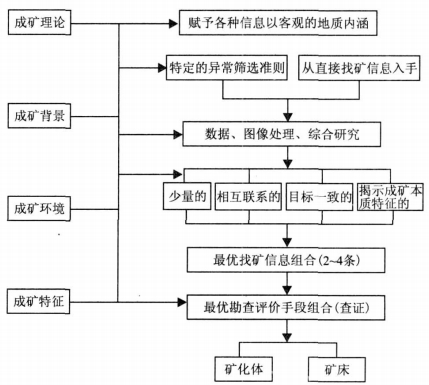|
Adams, S. S., Putnam, B. R. Ⅲ., 1992. In: Annels, A. E., ed., Case histories and methods in mineral resource evalution. Geological Society Special Publication, (63): 1-23. |
|
Agterberg, F. P., 1974. Geomathematics—Mathematical background and geoscience applications. Elsevier, Amsterdam, 596. |
|
Agterberg, F. P., Chung, C. F., Fabbri, G. A., et al., 1972. Geomathematical evaluation of copper and zinc potential of the Abitibi area, Ontario and Quebec. Paper-Geological Survey of Canada, 71-41, 43. |
|
Agterberg, F. P., Kelly, A. M., 1971. Geomathematical methods for use in prospecting. Canadian Mining Journal, 92 (5): 61-72. |
|
Allais, M., 1957. Method of appraising economic prospects of mining exploration over large territories—Algerian Sahara case study. Management Science, 3 (4): 285-347. doi: 10.1287/mnsc.3.4.285 |
|
Bonham-Carter, G. F., Agterberg, F. P., Wright, D. F., 1988. GIS for mineral exploration: Gold exploration in Nova Scotia (in GIS; integrating technology and geoscience applications, Thomas). Natl. Acad. Sci., Washington, DC, United States, 22-23. |
|
Chen, Y. C., 1999. Modern theories and methods on exploration and assessment of mineral resources. Seismological Press, Beijing (in Chinese). |
|
Chen, Y. C., Ye, T. Z., Zhang, H. T., 1999. Mineral resources assessment of major metallogenic provinces in China. Geological Publishing House, Beijing (in Chinese). |
|
Chen, Y. Q., Liu, H. G., 2001. A preliminary view on digital pattern for mineral exploration based on geoanomaly. Earth Science—Journal of China University of Geosciences, 26 (2): 129-134 (in Chinese with English abstract). |
|
Cheng, Y. Q., Chen, Y. C., Zhao, Y. M., 1979. Preliminary discussion on the problems of minerogenetic series of mineral deposits. Acta Geoscientia Sinica, 1 (1): 32-58 (in Chinese with English abstract). |
|
Cui, B., Li, Z., 1998. Synthetic metallogenic prediction in the material field-energy field-spatial field. Geoscience—Journal of Graduate School, China University of Geosciences, 12 (4): 501-505 (in Chinese with English abstract). |
|
Dai, Z. X., Wang, J. S., 2004. Hundred years of mineral exploration. Seismological Press, Beijing (in Chinese). |
|
Du, L. T., 2003. Lore of searching: Dialectics of "seeking". China Land Press, Beijing, 132 (in Chinese). |
|
Harris, D. P., 1965. An application of multivariate statistical analysis to mineral exploration. Pennsylvania State University at University Park, University Park, PA, United States, Doctoral Thesis, 278. |
|
Harris, D. P., 1973. A subjective probability appraisal of metal endowment of northern Sonora, Mexico. Economic Geology, 68 (8): 1345-1346. doi: 10.2113/gsecongeo.68.8.1345 |
|
Ji, K. J., Wang, L. B., 1994. The significant research progress of the source of hydrothermal solution and "triple-source" metasomatic hydrothermal metallogeny. Earth Science Frontiers, 1 (3-4): 126-132 (in Chinese with English abstract). |
|
Legge, P. J., 1995. Geoscience 1994 and beyond: Thoughts on geology and exploration for world-class ore deposits. Australian Journal of Earth Sciences, 42 (1): 1-10. doi: 10.1080/08120099508728174 |
|
Pei, R. F., Xiong, Q. Y., 1999. Hierarchy systematic metallogeny of a metallogenic province and assessment of mineral exploration. In: Chen, Y. C., ed., Modern theories and methods on exploration and assessment of mineral resources. Seismological Press, Beijing, 134-142 (in Chinese). |
|
Pei, R. F., Xiong, Q. Y., Shen, B. F., et al., 2001. Geological assessment of mineral resources potential for hard-identified concealed large and rich ore deposits. Geological Publishing House, Beijing (in Chinese). |
|
Shi, J. F., Yao, H. J., Li, Y. Z., et al., 2005.100 examples for strategy of informational exploration and exploitation. Geological Publishing House, Beijing (in Chinese). |
|
Singer, D. A., 1993. Basic concepts in three-part quantitative assessments of undiscovered mineral resources. Nonrenewable Resources, 2 (2): 69-81. doi: 10.1007/BF02272804 |
|
Sun, Q. Z., 1986. Marginal metallogeny: Interrelationship of spatiotemporal distribution and genesis of mineral deposits. Geology and Prospecting, 22 (1): 7-14 (in Chinese). |
|
Sun, Q. Z., 1994. Marginal mineralization and mineralization marginal effects. Earth Science Frontiers, 1 (4): 176-183 (in Chinese with English abstract). |
|
Wang, S. C., Chen, Y. L., Xia, L. X., 2002. The theory and method of mineral resources prediction of synthetic information. Science Press, Beijing (in Chinese). |
|
Wang, S. C., Chen, Y. Q., 1995. The theoretical system of comprehensive prognosis for gold ore-forming series. Gold Geology, 1 (1): 1-7 (in Chinese with English abstract). |
|
Warin, O. N., 1997. Mineral exploration into the millennium! Geoscientist, 7 (3): 5-6. |
|
Woodall, R., 1994. Empiricism and concept in successful mineral exploration. Australian Journal of Earth Sciences, 41 (1): 1-10. doi: 10.1080/08120099408728107 |
|
Wu, Q. L., Jiang, S. H., 2004. The analysis of predicting and decision-making. Southeast University Press, Nanjing (in Chinese). |
|
Xiao, K. Y., Zhang, X. H., Song, G. Y., et al., 1999. Development of GIS—Based mineral resources assessment system. Earth Science—Journal of China University of Geosciences, 24 (5): 525-528 (in Chinese with English abstract). |
|
Xie, S. C., Yin, H. F., 1997. Metallogenetic system of organism-organic matter-fluid. China University of Geosciences Press, Wuhan (in Chinese). |
|
Xie, X. J., 1997. New strategy for exploration of ore resources. Geophysical & Geochemical Exploration, 21 (6): 402-410 (in Chinese with English abstract). |
|
Yang, Z. X., 2000. Development and current state of metallogenetic regularities and predictions in western countries. Journal of Chengdu University of Technology, 27 (Suppl.): 259-263 (in Chinese with English abstract). |
|
Yin, H. F., Zhang, W. H., Zhang, Z. J., et al., 1999. The biometallogenesis system. China University of Geosciences Press, Wuhan (in Chinese). |
|
Zhang, B. X., 1999. A thinking for the studies of mineral deposits and the practice of exploration. Earth Science Frontiers, 6 (1): 1-12 (in Chinese with English abstract). |
|
Zhang, J., 1997. Present studying situation and trends of the location prediction of orebody. Advance in Earth Sciences, 12 (3): 242-246 (in Chinese with English abstract). |
|
Zhai, Y. S., 1998. The fabric frame and basic types of metallogenic system. In: Institute of Geochemistry of Chinese Academy of Sciences, ed., The symposium of seminar on resources and environment science about China sustainable development. Science Press, Beijing (in Chinese). |
|
Zhai, Y. S., 1999. On the metallogenic system. Earth Science Frontiers, 6 (1): 13-27 (in Chinese with English abstract). |
|
Zhai, Y. S., 2003. Research on metallogenic system. Geological Survey and Research, 26 (2): 65-71 (in Chinese with English abstract). |
|
Zhao, P. D., Chen, J. P., Chen, J. G., 2001. On diversity of mineralization and the spectrum of ore deposits. Earth Science—Journal of China University of Geosciences, 26 (2): 111-117 (in Chinese with English abstract). |
|
Zhao, P. D., Chen, J. P., Zhang, S. T., 2003. The new development of "three components" quantitative mineral prediction. Earth Science Frontiers, 10 (2): 455-463 (in Chinese with English abstract). |
|
Zhao, P. D., Chen, Y. Q., Li, J. P., et al., 1999. Theory and practice of geoanomaly in mineral exploration. China University of Geosciences Press, Wuhan (in Chinese). |
|
Zhao, Z. Y., Wang, S. C., Xu, Y. M., et al., 2002. Application and research of theory of mineral resources prognosis of synthetic information in the crises mine. World Geology, 21 (3): 283-286, 299 (in Chinese with English abstract). |
|
Zheng, Y. Y., Duo, J., Zhang, G. Y., et al., 2007. Discovery of Jiru porphyry copper deposit in Tibet and its significance. Mineral Deposits, 26 (3): 317-431 (in Chinese with English abstract). |
|
Zheng, Y. Y., Gao, S. B., Zhang, D. Q., et al., 2006. The discovery of the Zhunuo porphyry copper deposit in Tibet and its significance. Earth Science Frontiers, 13 (4): 233-239 (in Chinese with English abstract). |
|
Zhu, Y. S., 2006. Basic theory of mineral resources assessment—Theory system between regional metallogeny to mineral exploration. Acta Geologica Sinica, 80 (10): 1518-1527 (in Chinese with English abstract). |
|
Zhu, Y. S., Wang, F. T., Long, B. L., et al., 2003. Polygenic information prospecting model for Tuwu-Yandong porphyry Cu-Mo deposits. Mineral Deposits, 26 (3): 287-294 (in Chinese with English abstract). |
|
Zhu, Z. S., Zhang, Q. X., Yang, L. Q., et al., 1991. The seeking anomaly theory and nonmodel prediction. In: The fourth national conference of mathematical geology and the international reference of statistical prediction of ore deposits in Wuhan, China mathermatical geology (3). Geological Publishing House, Beijing, 49-55 (in Chinese). |
|
Zhu, Z. S., Zhu, L., 1998. Prediction theory and method system of deposits in China. Journal of Chengdu University of Technology, 25 (Suppl. ): 1-7 (in Chinese with English abstract). |
|
陈毓川, 1999. 当代矿产资源勘查评价的理论与方法. 北京: 地震出版社. |
|
陈毓川, 叶天竺, 张洪涛, 等, 1999. 中国主要成矿区带矿产资源远景评价. 北京: 地质出版社. |
|
陈永清, 刘红光, 2001. 初论地质异常数字找矿模型. 地球科学——中国地质大学学报, 26 (2): 129-134. |
|
程裕淇, 陈毓川, 赵一鸣, 1979. 初论矿床的成矿系列问题. 地球学报, 1 (1): 32-58. |
|
崔彬, 李忠, 1998. 物质场-能量场-空间场综合成矿预测. 现代地质, 12 (4): 501-505. |
|
戴自希, 王家枢, 2004. 矿产勘查百年. 北京: 地震出版社. |
|
杜乐天, 2003. 搜索学: "找"的辩证法. 北京: 中国大地出版社. |
|
季克俭, 王立本, 1994. 热液源研究的重要进展和"三源"交代热液成矿学说. 地学前缘, 1 (3-4): 126-132. |
|
裴荣富, 熊群尧, 1999. 金属成矿省等级体制成矿与矿产勘查评价. 见: 陈永清编, 当代矿产勘查评价的理论与方法. 北京: 地震出版社. |
|
裴荣富, 熊群尧, 沈保丰, 等, 2001. 难识别及隐伏大矿、富矿资源潜力的地质评价. 北京: 地质出版社. |
|
施俊法, 姚华军, 李友枝, 等, 2005. 信息找矿战略与勘查百例. 北京: 地质出版社. |
|
孙启祯, 1986. 论边缘成矿——关于金属矿床的时空分布及其成因联系. 地质与勘探, 22 (1): 7-14. |
|
孙启祯, 1994. 边缘成矿与成矿边缘效应. 地学前缘, 1 (4): 176-183. doi: 10.3321/j.issn:1005-2321.1994.04.021 |
|
王世称, 陈永良, 夏立显, 2002. 综合信息矿产预测理论与方法. 北京: 科学出版社. |
|
王世称, 陈永清, 1995. 金矿综合信息成矿系列预测理论体系. 黄金地质, 1 (1): 1-7. |
|
吴清烈, 蒋尚华, 2004. 预测与决策分析. 南京: 东南大学出版社. |
|
肖克炎, 张晓华, 宋国耀, 等, 1999. 应用GIS技术研制矿产资源评价系统. 地球科学——中国地质大学学报, 24 (5): 525-528. |
|
谢树成, 殷鸿福, 1997. 生物-有机质-流体成矿系统——以南京栖霞山铅锌银锰多金属矿床为例. 武汉: 中国地质大学出版社. |
|
谢学锦, 1997. 矿产勘查的新战略. 物探与化探, 21 (6): 402-410. |
|
阳正熙, 2000. 西方国家的"成矿规律和成矿预测"的发展和现状. 成都理工学院学报, 27 (增刊): 259-263. |
|
殷鸿福, 张文淮, 张志坚, 等, 1999. 生物成矿系统论. 武汉: 中国地质大学出版社. |
|
张炳熹, 1999. 浅谈矿床研究与勘查实践. 地学前缘, 6 (1): 1-12. doi: 10.3321/j.issn:1005-2321.1999.01.001 |
|
张均, 1997. 矿体定位预测的研究现状及趋向. 地球科学进展, 12 (3): 242-246. |
|
翟裕生, 1998. 成矿系统的结构框架和基本类型. 见: 中国科学院地球化学研究所编, 资源环境与可持续发展论文集. 北京: 科学出版社. |
|
翟裕生, 1999. 论成矿系统. 地学前缘, 6 (1): 13-27. doi: 10.3321/j.issn:1005-2321.1999.01.002 |
|
翟裕生, 2003. 成矿系统研究与找矿. 地质调查与研究, 26 (2): 65-71. doi: 10.3969/j.issn.1672-4135.2003.02.001 |
|
赵鹏大, 陈建平, 陈建国, 2001. 成矿多样性与矿床谱系. 地球科学——中国地质大学学报, 26 (2): 111-117. |
|
赵鹏大, 陈建平, 张寿庭, 2003. "三联式"成矿预测新进展. 地学前缘, 10 (2): 455-463. doi: 10.3321/j.issn:1005-2321.2003.02.025 |
|
赵鹏大, 陈永清, 刘吉平, 等, 1999. 地质异常成矿预测理论与实践. 武汉: 中国地质大学出版社. |
|
赵震宇, 王世称, 许亚明, 等, 2002. 综合信息矿产预测理论在危机矿山资源预测中的应用思考. 世界地质, 21 (3): 283-286, 299. doi: 10.3969/j.issn.1004-5589.2002.03.015 |
|
郑有业, 多吉, 张刚阳, 等, 2007. 西藏吉如斑岩铜矿床的发现过程及意义. 矿床地质, 26 (3): 317-431. doi: 10.3969/j.issn.0258-7106.2007.03.008 |
|
郑有业, 高顺宝, 张大全, 等, 2006. 西藏朱诺斑岩铜矿床发现的重大意义及启示. 地学前缘, 13 (4): 233-239. doi: 10.3321/j.issn:1005-2321.2006.04.021 |
|
朱裕生, 2006. 矿产预测理论——区域成矿学向矿产勘查延伸的理论体系. 地质学报, 80 (10): 1518-1527. doi: 10.3321/j.issn:0001-5717.2006.10.005 |
|
朱裕生, 王福同, 龙宝林, 等, 2003. 土屋-延东斑岩型铜(钼)矿床多源信息找矿模型. 矿床地质, 26 (3): 287-294. doi: 10.3969/j.issn.0258-7106.2003.03.010 |
|
朱章森, 张庆希, 杨丽清, 等, 1991. 求异理论与无模型预测. 见: 第四届全国数学地质会议—武汉国际矿床统计预测会议集, 中国数学地质(3). 北京: 地质出版社, 49-55. |
|
朱章森, 朱磊, 1998. 矿床定量预测理论与方法体系. 成都理工学院学报, 25 (增刊): 1-7. |










 下载:
下载:

